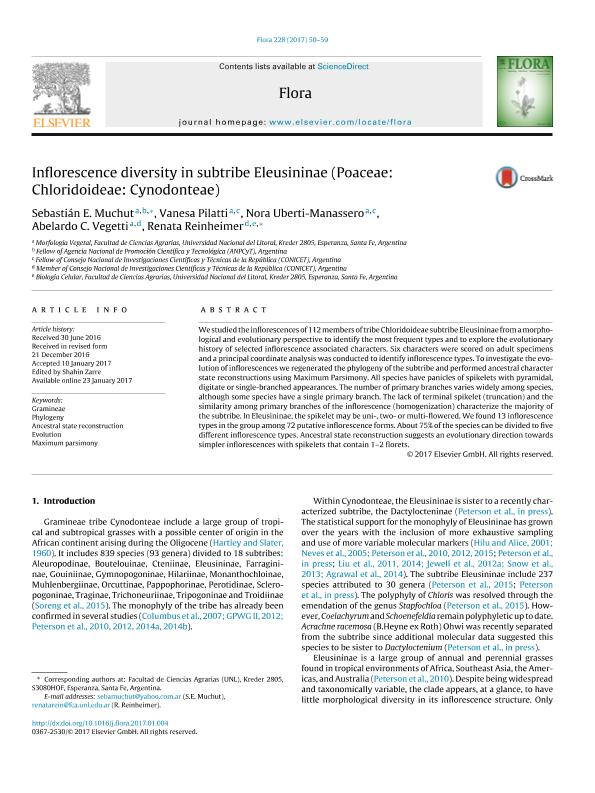Artículo
Inflorescence diversity in subtribe Eleusininae (Poaceae: Chloridoideae: Cynodonteae)
Muchut, Sebastián Elías ; Pilatti, Vanesa
; Pilatti, Vanesa ; Uberti Manassero, Nora Graciela
; Uberti Manassero, Nora Graciela ; Vegetti, Abelardo Carlos
; Vegetti, Abelardo Carlos ; Reinheimer, Renata
; Reinheimer, Renata
 ; Pilatti, Vanesa
; Pilatti, Vanesa ; Uberti Manassero, Nora Graciela
; Uberti Manassero, Nora Graciela ; Vegetti, Abelardo Carlos
; Vegetti, Abelardo Carlos ; Reinheimer, Renata
; Reinheimer, Renata
Fecha de publicación:
03/2017
Editorial:
Elsevier Gmbh
Revista:
Flora
ISSN:
0367-2530
Idioma:
Inglés
Tipo de recurso:
Artículo publicado
Clasificación temática:
Resumen
We studied the inflorescences of 112 members of tribe Chloridoideae subtribe Eleusininae from a morphological and evolutionary perspective to identify the most frequent types and to explore the evolutionary history of selected inflorescence associated characters. Six characters were scored on adult specimens and a principal coordinate analysis was conducted to identify inflorescence types. To investigate the evolution of inflorescences we regenerated the phylogeny of the subtribe and performed ancestral character state reconstructions using parsimony methodology. All species have panicles of spikelets with pyramidal, digitate or single-branched appearances. The number of primary branches varies widely among species, although some species have a single primary branch. The lack of terminal spikelet (truncation) and the similarity among primary branches of the inflorescence (homogenization) characterize the majority of the subtribe. In Eleusininae, the spikelet may be uni-, two- or multi-flowered. We found 13 inflorescence types in the group among 72 putative inflorescence forms. About 75% of the species can be divided to five different inflorescence types. Ancestral state reconstruction suggests an evolutionary direction towards simpler inflorescences with spikelets that contain 1-2 florets.
Archivos asociados
Licencia
Identificadores
Colecciones
Articulos(IAL)
Articulos de INSTITUTO DE AGROBIOTECNOLOGIA DEL LITORAL
Articulos de INSTITUTO DE AGROBIOTECNOLOGIA DEL LITORAL
Citación
Muchut, Sebastián Elías; Pilatti, Vanesa; Uberti Manassero, Nora Graciela; Vegetti, Abelardo Carlos; Reinheimer, Renata; Inflorescence diversity in subtribe Eleusininae (Poaceae: Chloridoideae: Cynodonteae); Elsevier Gmbh; Flora; 228; 3-2017; 50-59
Compartir
Altmétricas



